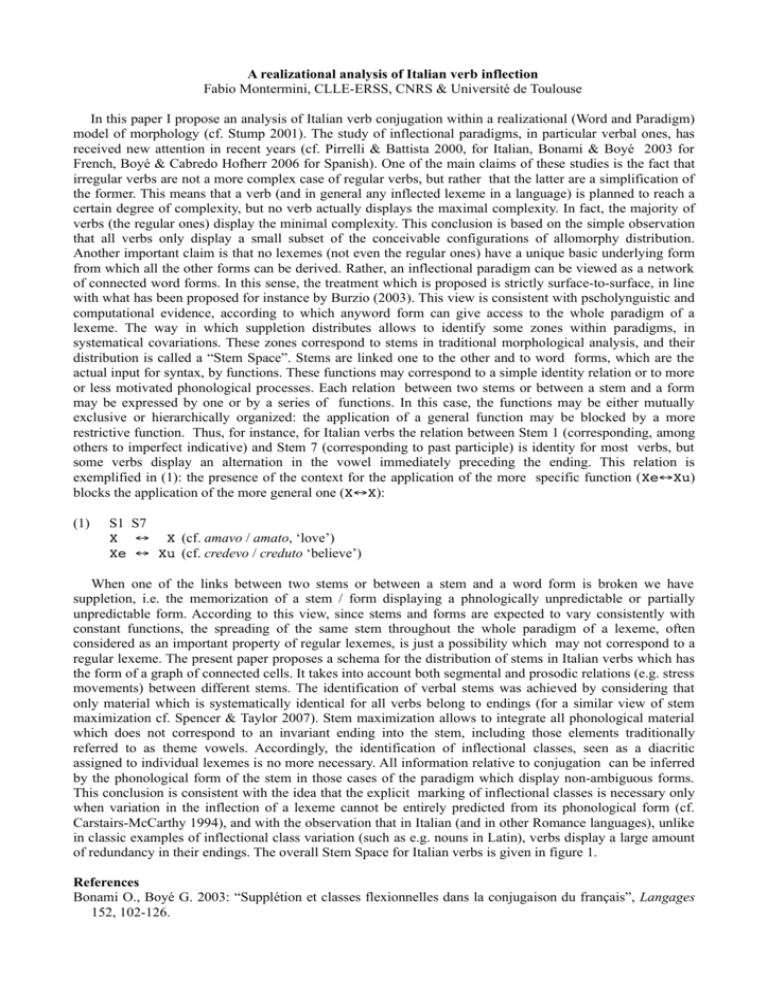A realizational analysis of Italian verb inflection Fabio Montermini
advertisement

A realizational analysis of Italian verb inflection Fabio Montermini, CLLE-ERSS, CNRS & Université de Toulouse In this paper I propose an analysis of Italian verb conjugation within a realizational (Word and Paradigm) model of morphology (cf. Stump 2001). The study of inflectional paradigms, in particular verbal ones, has received new attention in recent years (cf. Pirrelli & Battista 2000, for Italian, Bonami & Boyé 2003 for French, Boyé & Cabredo Hofherr 2006 for Spanish). One of the main claims of these studies is the fact that irregular verbs are not a more complex case of regular verbs, but rather that the latter are a simplification of the former. This means that a verb (and in general any inflected lexeme in a language) is planned to reach a certain degree of complexity, but no verb actually displays the maximal complexity. In fact, the majority of verbs (the regular ones) display the minimal complexity. This conclusion is based on the simple observation that all verbs only display a small subset of the conceivable configurations of allomorphy distribution. Another important claim is that no lexemes (not even the regular ones) have a unique basic underlying form from which all the other forms can be derived. Rather, an inflectional paradigm can be viewed as a network of connected word forms. In this sense, the treatment which is proposed is strictly surface-to-surface, in line with what has been proposed for instance by Burzio (2003). This view is consistent with pscholynguistic and computational evidence, according to which anyword form can give access to the whole paradigm of a lexeme. The way in which suppletion distributes allows to identify some zones within paradigms, in systematical covariations. These zones correspond to stems in traditional morphological analysis, and their distribution is called a “Stem Space”. Stems are linked one to the other and to word forms, which are the actual input for syntax, by functions. These functions may correspond to a simple identity relation or to more or less motivated phonological processes. Each relation between two stems or between a stem and a form may be expressed by one or by a series of functions. In this case, the functions may be either mutually exclusive or hierarchically organized: the application of a general function may be blocked by a more restrictive function. Thus, for instance, for Italian verbs the relation between Stem 1 (corresponding, among others to imperfect indicative) and Stem 7 (corresponding to past participle) is identity for most verbs, but some verbs display an alternation in the vowel immediately preceding the ending. This relation is exemplified in (1): the presence of the context for the application of the more specific function (Xe↔Xu) blocks the application of the more general one (X↔X): (1) S1 S7 X ↔ X (cf. amavo / amato, ‘love’) Xe ↔ Xu (cf. credevo / creduto ‘believe’) When one of the links between two stems or between a stem and a word form is broken we have suppletion, i.e. the memorization of a stem / form displaying a phnologically unpredictable or partially unpredictable form. According to this view, since stems and forms are expected to vary consistently with constant functions, the spreading of the same stem throughout the whole paradigm of a lexeme, often considered as an important property of regular lexemes, is just a possibility which may not correspond to a regular lexeme. The present paper proposes a schema for the distribution of stems in Italian verbs which has the form of a graph of connected cells. It takes into account both segmental and prosodic relations (e.g. stress movements) between different stems. The identification of verbal stems was achieved by considering that only material which is systematically identical for all verbs belong to endings (for a similar view of stem maximization cf. Spencer & Taylor 2007). Stem maximization allows to integrate all phonological material which does not correspond to an invariant ending into the stem, including those elements traditionally referred to as theme vowels. Accordingly, the identification of inflectional classes, seen as a diacritic assigned to individual lexemes is no more necessary. All information relative to conjugation can be inferred by the phonological form of the stem in those cases of the paradigm which display non-ambiguous forms. This conclusion is consistent with the idea that the explicit marking of inflectional classes is necessary only when variation in the inflection of a lexeme cannot be entirely predicted from its phonological form (cf. Carstairs-McCarthy 1994), and with the observation that in Italian (and in other Romance languages), unlike in classic examples of inflectional class variation (such as e.g. nouns in Latin), verbs display a large amount of redundancy in their endings. The overall Stem Space for Italian verbs is given in figure 1. References Bonami O., Boyé G. 2003: “Supplétion et classes flexionnelles dans la conjugaison du français”, Langages 152, 102-126. Boyé G., Cabredo-Hofherr P. 2006: “The structure of allomorphy in Spanish verb inflection”, Cuadernos de Lingüística del Instituto Universitario Ortega y Gasset 13: 9-24. Burzio L. 2003: “Output-to-Output faithfulness: The Italian connection” Lingue e Linguaggio 1: 69-104. Carstaits-McCarthy A. 1994: “Inflection classes, gender and the principle of contrast”, Lan- guage 70: 737788. Pirrelli V., Battista M. 2000: “The paradigmatic dimension of stem allomorphy in Italian verb inflection”, Italian Journal of Linguistics 12: 307-380. Spencer A., Taylor C. 2007: “Maximising stems”, paper presented at the MMM6 meeting, Ithaca, 27-30 September 2007. Stump G. 2001: Inflectional morphology, Cambridge, Cambridge University Press. Figure 1






